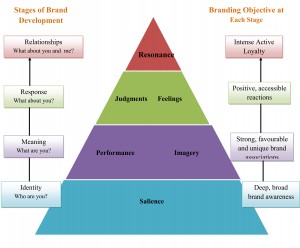Brand Resonance Pyramid
Definition
The Brand Resonance refers to the relationship that a consumer has with the product and how well he can relate with it.
The resonance is the intensity of customer’s psychological connection with the brand and the randomness to recall the brand in different consumption situations.
Meaning
Brand resonance is characterized by strong connections between the consumer and the brand. Brands with strong resonance benefit from increased customer loyalty and decreased vulnerability to competitive marketing actions. The challenge for the brand is to ensure that the customer has the right experiences to create the right brand knowledge.
Brand Resonance Pyramid/Stages of Brand Development
Building this resonance involves a series of steps, as seen in Figure given below:

Building this resonance involves a series of steps:
The first level of the pyramid deals with establishing the identity of the brand. Keller suggests a single building block for this phase and terms it brand salience. Salience refers to how easily or often a consumer thinks of the brand, especially at the right place and right time. In building a highly salient brand, he argues that it is important that awareness campaigns not only build depth (ensuring that a brand will be remembered and the ease with which it is) but also breadth (the range of situations in which the brand comes to mind as something that should be purchased or used).
The second layer of the pyramid deals with giving meaning to the brand and here Keller presents two building blocks: brand performance and brand imagery. Brand performance is the way the product or service attempts to meet the consumer’s functional needs. Brand performance also has a major influence on how consumers experience a brand as well as what the brand owner and others say about the brand.
Delivering a product or service that meets and, hopefully, exceeds consumer needs and wants is a prerequisite for successful brand building. In communicating brand performance, Keller identifies five areas that need to be communicated: primary ingredients and supplementary features; product reliability, durability and serviceability; service effectiveness, efficiency and empathy; style and design; and price
Brand imagery deals with the way in which the brand attempts to meet customers’ psychological and social needs. Brand imagery is the intangible aspects of a brand that consumers pick up because it fits their demographic profile (such as age or income) or has psychological appeal in that it matches their outlook on life (conservative, traditional, liberal, creative,etc). Brand imagery is also formed by associations of usage (at work or home) or via personality traits (honest, lively, competent, rugged, etc).
It is in this building block that advertising plays a major role in shaping the image of the brand, although word-of-mouth recommendations and a consumer’s own experience are equally important. However brand imagery is built, it is important that brand managers and strategists craft strong, favourable and unique associations for a brand.
Luxury cars, BMW in particular, are brands that work hard to communicate brand performance and imagery. Sales people, brochures, Internet sites and car journal reviews will all tell you about the performance of a BMW. The delivery of this type of communication has largely remained consistent, only being updated at regular intervals to reflect the specifications of new models. What has changed is the imagery used to communicate the brand from the power-impregnated advertisements of a BMW outrunning a land speed rocket car to the more esoteric imagery of innovative kinetic sculptures being powered by the wind. The change in advertising imagery reflects a shift by the German automaker away from targeting the affluent automobile enthusiast to targeting the “ideas class”, a market segment which comprises up-market buyers more interested in design and innovation than brute performance.
Third level of the pyramid develops a consumer response to the brand. Keller proposes two building blocks for this tier, namely brand judgments and brand feelings. Judgments about a brand emerge from a consumer pulling together different performance and imagery associations. These judgments combine into a consumer’s opinion of a brand and whilst there are multiple judgments that an individual can make, Keller believes there are four that companies must pay attention to in their brand-building efforts. They are the perceived quality of the brand; brand credibility (the extent to which the brand is perceived as having expertise, being trustworthy and likable); brand consideration (the brand must be relevant to the consumer so that they are likely to purchase or use it); and brand superiority (the extent to which consumers view the brand as being unique and better than other brands).
Maintaining brand judgement is particularly important when a company embarks on brand extension as what counted as quality, credibility, consideration and superiority in one market can evaporate as the brand extends its product line and/or market reach. Baby food manufacturer Gerber tried to enter the adult food market in the 1970s by producing small helpings of fruits, vegetables, desserts, etc in the same jars it used for infant food. Unable to garner credibility (adult food is very different to baby food), consideration (how many adults would think about buying food for themselves that is packaged in a well-established baby-food jar) and superiority (many other brands specialize in adult food) for its new product range, Gerber quickly ditched which was widely regarded as a spectacular failure.

